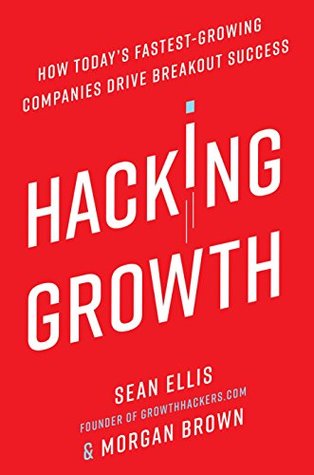More on this book
Community
Kindle Notes & Highlights
by
Sean Ellis
Started reading
July 4, 2018
too many companies do not place enough emphasis on data analysis, and rely too heavily on prepackaged programs, such as Google Analytics, with limited capacity for combining various pools of data, such as from sales and from customer service, and limited ability to delve into that data to make discoveries.
quickly abandoning those that show lackluster results.
think of it speeding along like a Formula One racing car making precision adjustments, in contrast to a runaway truck whose brakes have gone out.
waned
linchpin
fervent
keeping its sights on sustaining that growth.
ultimately buying the competitor in 2015 for $3 billion.
Copytune, a highly sophisticated machine learning algorithm, which allowed them to rapidly test dozens of variants of notifications sent to users, across more than 30 languages, and have the software pick winning versions and tee up subsequent tests in search of even better performance.
LORE
leery
Overcoming this resistance required lots of cross-team collaboration and trust building. “We had to do a lot of work to get support from the partner teams,” he recounts.
strife
Engineers tend to be most interested in working on the most technically challenging jobs, whether or not the solutions they come up with will have a meaningful impact on growth. Product managers are typically obsessed with product development and launches and can be infuriated by marketing and sales teams making last-minute requests for changes with poor business rationales. User experience designers often resist the introduction of experimental features for testing because they don’t want to upset happy users with annoyances. Marketers can become focused on vanity metrics such as the number
...more
calls the “lore” that holds sway about how products should be designed or what customers want.
Every company, large or small, has entrenched lore that should be blasted away by data-driven experimentation.
clientele.
dissent
And when experimentation is data driven, team members also generally respect the rigor of the learning process and appreciate the latitude it gives them to rack up a string of failures in order to achieve a win.
the fixation on growth stays in its DNA.
Even the most inspired products and ideas can, and often do, stall out and ultimately crash and burn due to the failure to continuously improve them.
They’ve built products that, in the eyes of their customers, are simply must-have.
that it can sometimes take enormous patience, because the pressure to start pushing for growth is intense.
the belief that growth can be forced, usually by increasing spending on marketing, becomes increasingly alluring.
pernicious
deluge
conceded
resounding
thud
preordained.
anemic
avid
enthused
touting
the language they use to describe the product to their friends can unearth benefits, features, and language to use in your own product promotion.
the first thing to do is to stop yourself from doing something that feels all too natural: guessing at what the elusive feature might be that may make your product more appealing to your customers. Sitting in an office with your smartest lieutenants and a whiteboard to hash out ideas for improvements may feel like exactly the right way to solve the problem, but trust us, that instinct is a head fake.
dispassionate
laden
sororities
scoured
(1) Can you tell us why you signed up in the first place?; (2) What didn’t work for you? Why’d you bail?; (3) What caused you to come back and try it again?; and (4) What worked this time?
Decisions about what experiments to run must be made rigorously, and most growth teams have adopted the practice of a minimum viable test (MVT), the least costly experiment that can be run to adequately vet an idea. If the MVT is successful, the team will invest in a more robust follow-on test or more polished implementation of the concept.25
an A/B test of the copy on the sign-up page revealed that simply changing the language from “Sign Up for Free Trial” to “See Plans and Pricing” netted 200 percent more sign-ups.26 That might seem like a rare case, but it’s not; in the companies we’ve worked with we’ve seen hundreds of examples of other equally simple changes—revealed through A/B testing—that have led customers to the aha moment and in turn driven massive increases in adoption.
But other, less-battle-tested changes such as substantial redesigns or building of new product features should be done only on the basis of a strong hypothesis, formed through the analysis of user research and data. In other words, for tests that are time- and labor-intensive, teams should minimize the risk of this investment of effort with sound reasoning first, and mix bigger, riskier initiatives in with more sure things. In doing so the team will ensure that it strikes the right balance between big, moonshot bets and incremental improvements that lead to consistent growth.
“invalidate lore”
James Currier, a successful entrepreneur and growth expert turned venture capitalist, suggests that one-third of a company’s engineering time goes to getting the new user experience down just right.
Take the case of Everpix, which was one of the most highly regarded photo apps in recent memory. Designed for users who were tired of the hassles involved with managing large collections of photos on their devices, the service made the process effortless. Brilliantly designed, and praised by critics, the app was a snap to get the hang of and also boasted an average 4.5-star user rating. TechCrunch raved, “The best part about Everpix may be its ‘set it and forget it’ nature. After the onetime installation and configuration, there’s nothing else you have to do.”1 The product’s initial base of
...more
coffers
Instead they kept focusing on improving the product; for example, by offering a feature that sent users an email with photos they’d taken on the same day the prior year.


